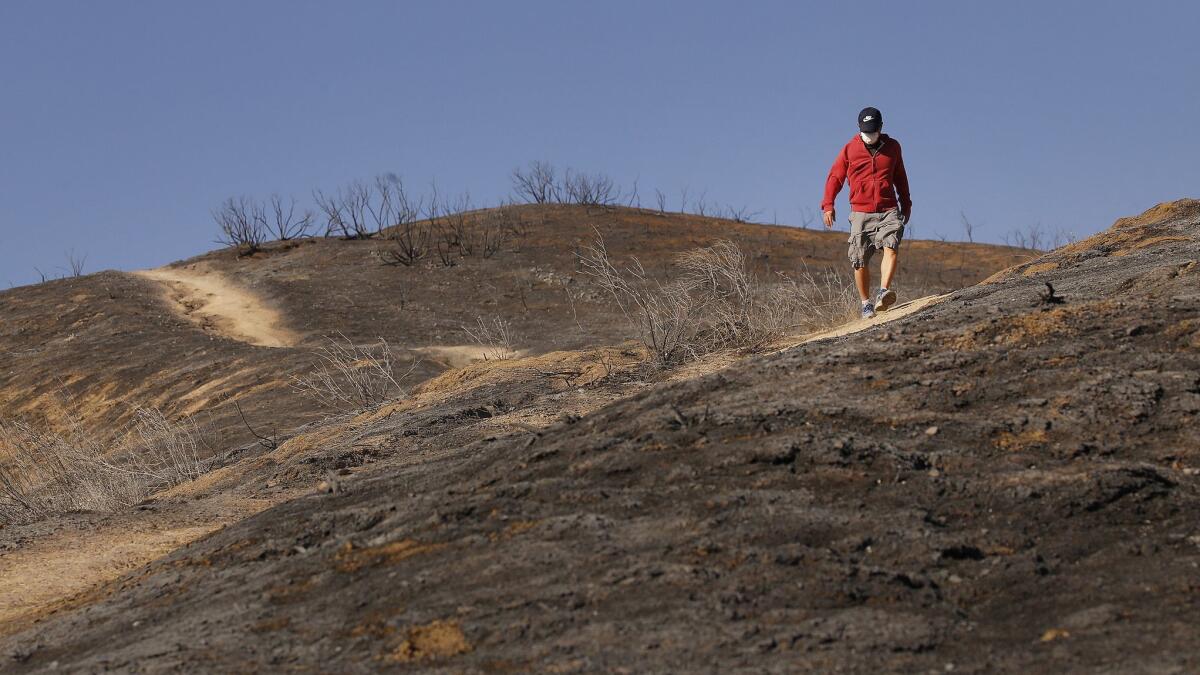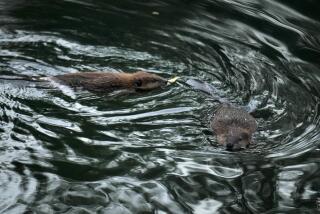It will take ’10 to 20 years’ before Santa Monica Mountains look like they did before Woolsey fire

Two dozen biologists with binoculars and telemetry equipment fanned out across the smoldering gulches and slopes of the Santa Monica Mountains National Recreation Area on Friday to take a preliminary accounting of the damage caused by wildfire to prime mountain lion country.
It was arduous, dusty work, traipsing through shrub lands reduced to piles of white ash and denuded canyons. But the data they gathered were cause for cautious optimism.
Of 13 mountain lions with radio collars they had been tracking before the Woolsey fire broke out, scientists confirmed that 12 were alive and moving outside of the burned areas in the vicinity of Point Mugu to the west, and from Malibu east to the 405 Freeway, scientists said.
One lion, a sub-adult known as P-74, remained unaccounted for.
Though Southern California’s urban mountain lions have become a fixture in popular imagination, they are an imperiled breed living at the very limit of what is ecologically possible. Now biologists are watching, unsure of what’s next in the area where many of the creature comforts that the large predators need to breed, hide and hunt deer were lost after the Woolsey fire roared through.
“The national recreation area has become an immense natural experiment,” Seth Riley, a National Park Service ecologist, said. “The big question now is this: What happens when a huge wildlife refuge hemmed by freeways and development abruptly loses more than half of its habitat to wildfire?”
For miles and miles in the Santa Monica Mountains, from ridgeline to ridgeline in all directions, the Woolsey fire exacted a heavy toll, burning 100,000 acres — 88% of the area’s federal parkland.
It is a huge loss for an unlikely wilderness that has persisted for decades through dogged conservation despite surrounding urban sprawl.

Public access to the range was hard fought by a bipartisan coalition of conservation and civic groups starting in the 1960s. Their goal: a unique combination of city, county, state and federal land, together with beaches, trails and scenic corridors that would run from Griffith Park to Point Mugu in Ventura County.
In 1978, Congress awarded their efforts by authorizing the Santa Monica Mountains National Recreation Area to provide open space in one of the nation’s most congested, polluted and park-poor regions.
Over the past 40 years, its trails have become a destination for hikers, mountain bikers, bird-watchers and equestrians, its roads a fixture for car commercials and motorcycle clubs and its creeks a draw for busloads of schoolchildren from throughout the region.
Today, the chaparral highlands and sandstone peaks offer panoramic views of stubble and ash. Entry is restricted to people credentialed to work in fire zones.
The fire burned the life out of hiking trails some say rank with such iconic paths as the John Muir Trail in the Sierra Nevada range and the Appalachian Trail in the East. Completed in 2016 after a half-century of hard work and altruism, the Backbone stretches through 67 miles of sycamores, chaparral and sandstone peaks between Point Mugu State Park and Will Rogers State Historic Park. Officials said segments of the Backbone trail within the Woolsey fire’s footprint remain closed.
Emily Pruitt, a spokeswoman for the National Park Service, said it is too early to know when burned sections of the recreation area will reopen.
“The fire destroyed at least 616 structures within the park,” she said, “and there are still a lot of potential hazards to be assessed.”

Properties with links to show business were destroyed. Among them were Paramount Ranch and sets used for HBO’s hit series “Westworld” — both popular destination points for day trippers who used the background for family photos and Instagram posts.
“Most ecologists say it will take 10 to 20 years for the Santa Monica Mountains to look the way they did before the Woolsey fire came through,” said Mark Mendelsohn, a National Park Service biologist. “Of course, that depends on rainfall and drought.”
When it comes to native species, he said, “this fire means they are going to struggle, some more than others.”
One of the largest mountain lion populations in Southern California is confined within 275 square miles in an around the Santa Monica Mountains National Recreation Area, which is bordered by the Pacific Ocean, major freeways, housing and commercial developments and agricultural fields.
Studies begun in 2002 suggest the pre-fire landscape may have reached capacity with about 15 to 20 mountain lions. Inbreeding is a serious problem among these big cats, which have extremely low genetic diversity. The males will fight and kill others for territory, which is vastly more limited after the Woolsey fire.
A charred sign just west of Liberty Canyon Road and a stone’s throw from the 101 Freeway in Agoura Hills still stands in a critical wildlife corridor where conservationists hope to build a wildlife bridge. It would allow safe passage and help diversify the gene pool among the groups of mountain lions remaining in the Santa Monicas south of the freeway as well as in the Simi Hills and Santa Susana mountains to the north.
Now, the site of what aims to be one of the most ambitious predator restoration projects in the United States is surrounded by miles of charred hills and mountains.
Whenever conditions change, there will be winners and losers. Mendelsohn has witnessed plenty of heartbreaking evidence of both during recent surveys of the still-smoldering landscape.
“Some animals didn’t make it,” he said. “But it was encouraging to see a deer in a completely charred forest, a tiny wren tit hunkering down in one of the few shrubs left standing, and a woodrat leap out from under a rock near where its nest had burned.”
It didn’t take long for Mendelsohn to find the natural sounds he was searching for as he strode along a creek edged with singed reeds and brush in the Upper Las Virgenes Canyon Open Space Preserve area of Agoura Hills.
It was home to an isolated population of federally threatened red-legged frogs discovered in 1998, and a place where biologists gather eggs used in reintroduction programs elsewhere in the recreation area.
“Five plopping sounds in the water gave me a sense of cautious relief,” he said.
Federal biologists are discussing proposals to capture the frog population, if necessary, in the event a large storm threatens to bury one of the species’ last outposts in Los Angeles and Ventura counties in mud and debris.
There was good news in Topanga Canyon, where firefighters avoided dropping retardant that would have decimated a Malibu Creek habitat that’s home to frogs, newts and protected fish such as Arroyo chubs and federally endangered southern steelhead trout.
“Topanga Canyon was spared,” biologist Rosi Dagit said. “I recently stood on a roadside pullout overlooking the stream and shouted, ‘Thank god, you didn’t burn!’ ”
For now, and in the years ahead, biologists will focus attention on how the mobile, efficient predators at the top of the area’s food chain are faring, and their impacts on recovering plant and animal populations.
The surprise is that nearly all of the mountain lions with radio collars turned up outside of the fire’s burn area.
“It is not clear whether one or more of those mountain lions outran the fire to safer conditions, or just happened to be there by some amazing coincidence when the fire broke out,” said Riley, the National Park Service ecologist.
Questions remain about how these big cats — already living closer to their peers than they are predisposed to — will endure in even tighter confines.
There may be repercussions, and not just for the mountain lion population. “People really need to protect their animals,” Riley said, “now that there are fewer deer on the landscape.”
What started as a tiny brush fire became the state’s deadliest wildfire. Here’s how »
More to Read
Start your day right
Sign up for Essential California for news, features and recommendations from the L.A. Times and beyond in your inbox six days a week.
You may occasionally receive promotional content from the Los Angeles Times.







